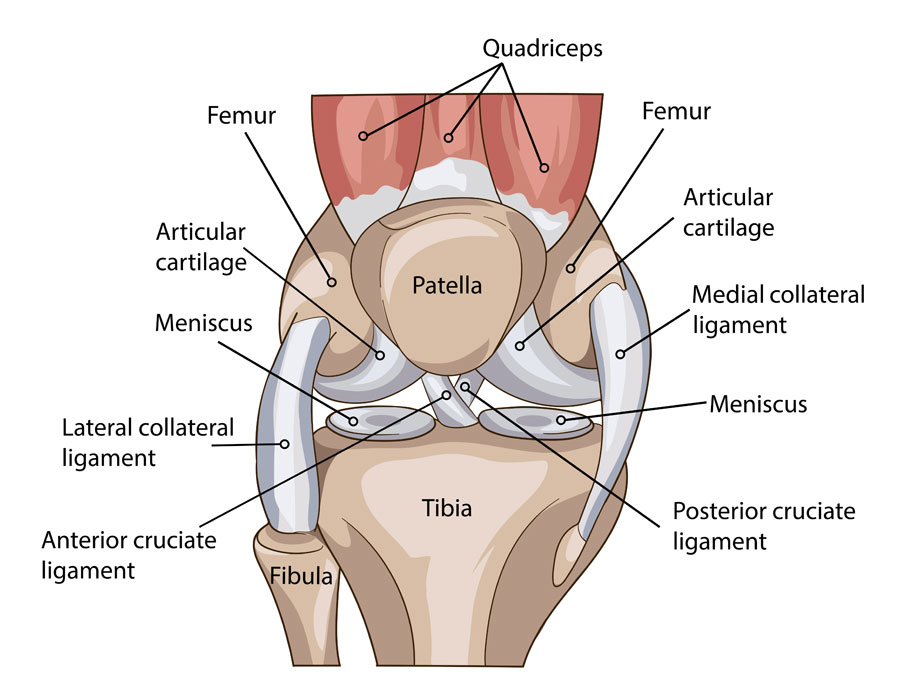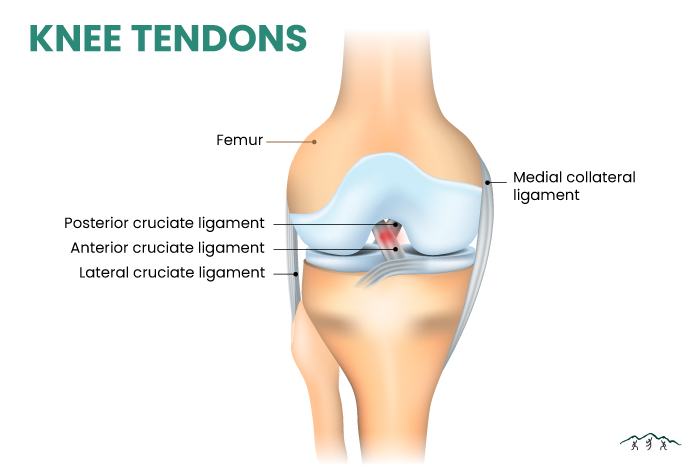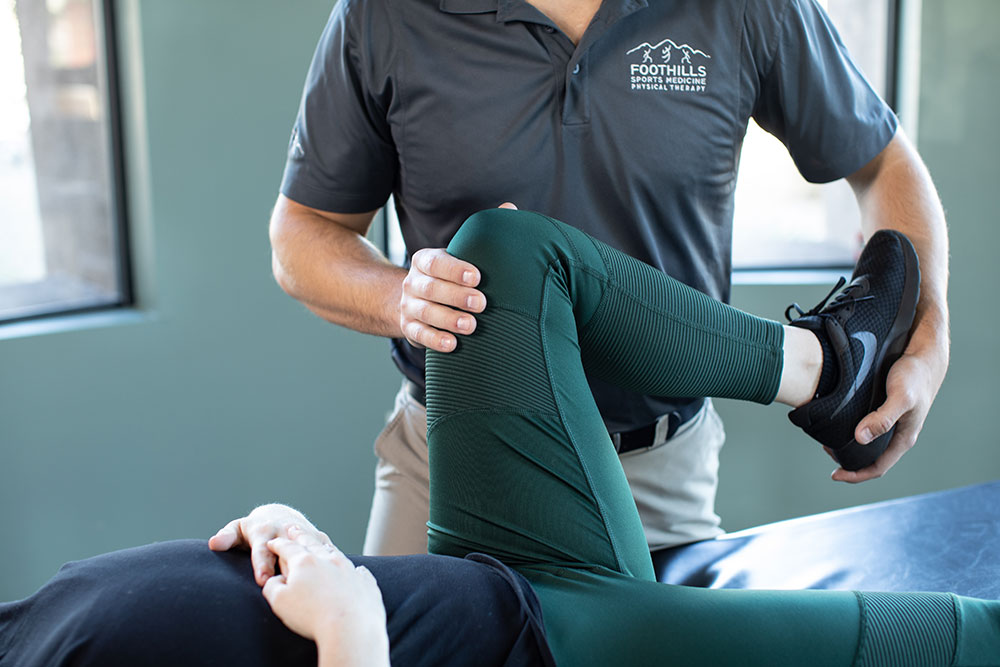Knee injuries are some of the most common occurrences in sports and athletics. The knee is one of the most significant weight-bearing joints of the body, meaning that it undergoes a lot of pressure when we run, jump, or do other physical activities, like heavy lifting. The structure of the knee joint is relatively simple, essentially only straightening and bending with a small amount of rotation. Excessive rotation or twisting during activity is a very common mechanism for knee injuries in addition to heavy loading on the joints and muscles.
There are a vast number of injuries or conditions that can impact the knee and/or cause pain. This article will cover the anatomy of the knee, causes of knee pain, and common sports injuries.
Anatomy of the Knee
The knee joint is formed from the connection of the femur (thigh bone), tibia and fibula (shin bones), and patella (kneecap), along with cartilage, tendons, ligaments, and muscles. The quadriceps and hamstring muscles of the front and back of the thigh cross the knee joint and their tendons connect to the tibia and fibula causing the knee to bend or straighten. The ligaments connect the bones together and help to control the amount of motion in the joint to keep it stable. The cartilage on the end of each bone forms a smooth area for them to move against each other and prevent friction as well as help cushion the joint from impact.

Knee Injuries and Related Symptoms
There are many variables that may cause an injury to one or more of the structures of the knee and cause pain, each with different severity and symptoms. Some of the most common signs or symptoms of an injury:
- Redness and warmth
- Popping or crunching sounds
- Swelling and stiffness
- Locking, catching, or inability to straighten the knee
- Weakness or instability
Not all knee pain is worthy of a visit to your Physician, but you should go whenever you feel concerned about the pain or level of discomfort. There are several occasions when seeing a Physician may be necessary, including:
- Inability to flex or extend your knee
- Inability to stand or walk
- Severe swelling
- Apparent deformity in the knee or leg
- Severe pain
- Experiencing a fever in combination with redness, swelling, and pain
11 Common Knee Injuries
Knee pain is not specific to one specific injury or cause. There are many potential problems that can result in pain. However, the most common knee injuries and other causes of knee pain include the following conditions.

- Muscle strains
Muscle strains are the most common cause of knee injuries. Muscle strains occur when the fibers of the muscles are torn during activity. This can be mild from a hard workout that leaves you sore for a few days, all the way to severe when a muscle is completely torn in two and requires surgery.
- Tendon Tears
Tendon tears are like muscle strains in that they occur when small tears happen in a tendon during activity and vary in severity. Complete tears can be caused by a tendon that is weakened by chronic degeneration due to overuse, or from a healthy tendon that experienced excessive stretching during high-energy activities. Other common causes involve landing awkwardly after jumping, or direct impact to the tendon on the front of the knee, and falling. While most common with middle-aged athletes, these injuries can happen to anyone.
- Meniscal Tears
The meniscus is a cartilaginous structure in the knee that helps to absorb force, helps deepen the joint surface and provides greater stability. Meniscal tears are a fairly common injury in sports, but they can also occur as a general part of the aging process. These injuries are often the result of twisting, pivoting, and cutting motions during activity.

- Posterior Cruciate Ligament Injuries
Posterior cruciate ligament, or PCL, injuries are typically not as severe as other tears, which is why you might not hear about this type of injury until it happens to you. In most instances, the ligament tear is partial and can heal on its own, and rarely is fixed surgically even if completely ruptured. These injuries occur when the knee is impacted in a bent position, meaning they are more common in car accidents and sports.
- Anterior Cruciate Ligament Injuries
The anterior cruciate ligament, or ACL, is a common injury among athletes. In more demanding contact sports like football, basketball, and soccer these injuries can occur from landing incorrectly from a jump, attempting to change directions quickly, or from athletes getting tangled up with or landing on each other. An injured ACL often accompanies other injuries within the knee and are more common in young female athletes.
- Collateral Ligament Injuries
The collateral ligaments include the medial collateral ligament and the lateral collateral ligament, which connect the femur to the tibia on the inside of the knee and the fibula on the outside of the knee. Injuries to these ligaments result from direct blows to either side of the knee and typically occur in sports with a lot of side-to-side movements such as soccer, football, and hockey.

- Arthritis
Not all forms of arthritis will cause knee pain, but several will, including rheumatoid arthritis, osteoarthritis, and septic arthritis where there is an infection inside the knee joint itself. Osteoarthritis is the most common form of arthritis that affects the knees and other joints, and can be caused by injuries or simply as a part of the aging process. Arthritis can lead to the deterioration of the cartilage at the articular surface of the joint and it typically worsens with age. Early intervention and focused exercise can help strengthen and stabilize the joint to slow further progression.
- Loose Body
Another source of knee pain that can stem from a previous injury is a loose body in the joint. A previous dislocation or fracture might have caused a piece of cartilage or bone to be ripped or chipped off and float in the joint space. This is also referred to as “joint mice”. While loose bodies in joints can go unnoticed and be symptom-free if it begins to interfere with the joint surface and gets caught it can result in discomfort and pain. The solution is typically a minor surgery.
- Iliotibial Band Syndrome
Iliotibial band syndrome primarily affects distance cyclists and runners and it can cause significant pain in the outside of the knee. The syndrome occurs when the iliotibial band, which extends from the outside of the hip to the outside of the knee and fibula, rubs against the femur. This can be caused by poor mechanics with activity, bad body positioning, and weakness in the hips. Correcting these issues can help resolve this pain.
- Dislocation
Dislocations are often the result of high energy traumas or sports-related injuries and occur when the bones of the knee joint become out of alignment. Some dislocations are relatively common, such as people who have an unstable patella that causes minor dislocations from minimal traumatic incidents. Other knee dislocations, where the femur and tibia are concerned, are a medical emergency and likely involve injuries to the ligaments and tendons, and thus could involve important nerves and blood vessels to the leg as well.

- Fractures
Knee fractures are often painful and occur in the patella. These injuries typically occur because of a direct fall onto the knee or from a sudden blow to the front of the knee. It’s also possible for the patella to break indirectly from sudden contractions of muscles near the bone. The tibia and femur can also be fractured from impacts to the thigh or lower leg. Regardless of the type of fracture, most result from high-energy trauma, like that experienced in a car accident, fall, or sports injury.
Other Causes of Knee Pain
Knee pain does not always stem from a knee injury. Sometimes, foot or hip issues can lead to knee pain by forcing you to limp, favoring one leg over the other, and placing more strain on your knees. When knee pain cannot be easily explained, it is often best to examine the joints above and below the knee and how they might contribute to or affect the knee.
There are a few things you can do to help prevent knee injuries, including the following:
- Perform regular exercise to strengthen the muscles of your leg
- Wear appropriate protective equipment when playing a sport with a high risk of falling or impact
- Replace your shoes as they wear out
- Be sure to warm up and cool down before and after physical activity
- Make gradual changes to the intensity of your workouts to give your body time to adjust
Do you experience knee pain or discomfort? Contact the professionals at Foothills Sports Medicine Physical Therapy to schedule an appointment.





